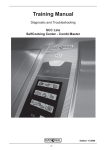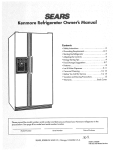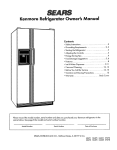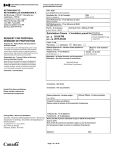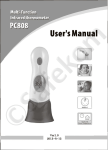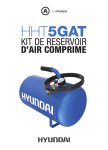Download Care & Cleaning
Transcript
_t :_ tt ;;iiii ;!ii_ t Congratulations on your purchase of a Maytag Performa refrigerator! Your satisfaction is very important to us, so please read this guide very carefully. You will find instructions on the proper operation and mainteTM nance of your new appliance. Save time and money. If something should go wrong, we suggest consulting the "Before You Call" section. It is designed to help you solve basic problems before consulting a servicer. If you have questions, write us (include your model number and phone number) or call: Maytag Appliances Sales Company ! t Table of Safety Instructions_i Installation ............ .. Temperature Controls Looking inside Ice Service Food .................. ....................... Storage Tips ................. 6 Attn: CA/R ®Center P.O. Box 2370 Cleveland, TN 37320-2370 1-800-688-9900 USA Storingthe Refrigerator, Care & Cleaning................... 8 1-800-688-2002 CANADA Cleaning Chart .................... 9 1-800-688-2080 USA TTY (for deaf, hearing impaired or speech impaired) (Mon.-Fri., 8am-8pm Eastern Time) Internet: http: / / www.maytag.com Part No. 111208-1 Form No.A/02/00 MCS Part No. 61005031 7 Before You Call ................... Warranty ........................ Guide de L'Utilisateur ............. 10 Guia del Usuario ................. 24 11 12 Litho U.S.A. For Future Assistance Have complete model and serial number identification of your refrigerator. This is located on a data plate inside the refrigerator compartment, on the upper left side. Record these numbers below for easy acccess. Model Number Serial Number Important [ _ Safety WARNING: When using your NOTE: In our continuing effort to improve the quaf ity of our appliances, it may be necessary to makl changes to the appliance without revising thi= guide. Instructions appliance, always follow basic precautions, including the following: • Use the refrigerator only for its intended purpose. • To prevent possibility of hazard due to electrical shock, never plug the refrigerator into a receptacle which has not been grounded adequately and in accordance with the local and national electrical codes. See _ warning and the grounding instructions below, • Unplug the refrigerator before cleaning or replacing a light bulb. • In case of power failure, minimize door openings. If the power failure is of a long duration, protect the food by placing blocks of dry ice on top of the packages or check with a local frozen foods locker plant about ternporary storage. Frozen foods which have thawed cornpletely should not be refrozen, • Any electrical service cord that becomes frayed or damaged should be immediately repaired or replaced. Never unplug your appliance by pulling on the power cord. • Your refrigerator should not be operated ence of explosive fumes. Have proof of original date of purchase, Keep your sa slip, proof of original purchase date is needed for w ranty service. • Children should not climb, hang or stand shelves of this refrigerator. on Important: Child entrapment and suffocation are 1 problems of the past. Junked or abandoned refrige tors are still dangerous.., even if they will sit for "ju: few days." If you are getting rid of your old refrigerator, please follow the instructions below to help prevent accidents. • Take off the doors. • Leave the shelves in place so that children may not easily climb inside. in the pres- _k WARNING -- This appliance is designed to operate on a normal 115 volt, 15 amp, 60 cycle line. The should be a separate, grounded circuit serving this appliance only. Do not use an extension cord. L not use any device that will alter the electrical performance of this appliance, Power supply cord with 3-prong This appliance is equipped with a three-pronged ground- shock hazards. It must be plugged into a grounding receptacle. Where a standard two-prong wall receptacle is encountered, it is the personal responsibility and obligation of the customer to have it replaced with a properly grounded three-prong wall receptacle. Do not under any circumstances, cut or remove against the thirdpossible (ground)electrical prong ing plug for your protection from the power cord. Do not use an adapter plug. 1 SAVE THESE grounding cord. I I _ INSTRUCTIONS _ I Groundingtype wall receptacl Installation Your new refrigerator was packed carefully for shipment. Remove and discard shelf packing clips (if used) located just abov, each shelf where they hook onto the frame. To remove plastic clips wiggle the clips sideways and pull straight out. Location Leveling • Allow for a free flow of air through the front base grille, Your refrigerator is equipped with front and back rolle so it can be moved away from the wall for cleaning. " enhance its appearance and to maintain performan( your refrigerator should be level. • Install the refrigerator where the room temperature will not go below 55° E With temperatures below 55°, the refrigerator will not run frequently enough to maintain proper temperature in the freezer. For refrigerator models with adjustable wheels: • Remove the base grille by grasping both ends ar • Allow a minimum 1/2" clearance on the sides, top and back for ease of installation. If refrigerator is placed with the door hinge side against a wall, you pulling straight out (seefig. 1). • Adjust the wheels with a screwdriver socket (see fig. 2). may want to allow additional be opened wider, • Use caution when installing • To prevent the refrigerator from rolling, use the le eling/lock screws. Turning down both levelil screws locks the cabinet into place (see fig. 3). space so the door can the unit on vinyl or hardwood floors so as not to mark or otherwise damage the flooring. A piece of plywood, a rug or other material should be used to protect while positioning the unit. the floor or a 1/_ • To replace the base grille, align the spring clips wi the round openings in the cabinet and push each el in until the grille locks into place. For all other models: • Adjust the leveling/lock screws beneath each frc corner at the base of the cabinet. Turn these lev, ing/lock screws clockwise to raise a cabinet corr and counterclockwise to lower a cabinet corner (s fig. 3). • If the floor is not level and it is necessary to raise t rear of the cabinet, we suggest rolling the rear wheq onto a piece of plywood or other shim material. Fig, 1 I TURN CLOCKWISE RAISE CABINET TO CORNER _ COUNTER-CLOCKWISE TO LOWER CABINET CORNER Fig. 2 Fig. 3 Temperature Your refrigerator compartment. Controls has two temperature controls. These controls are located Allow 24 hours FREEZEPCON f_OL between aaiustments Initio setting : 4 (Mid selting) 4=MD .... To adiust the controls, grasp the underside Initial Temperature Settings FI?ESHFOOD CONTF_OL _ID of the control knob and turn. Control • The fresh food control has settings from 1 (warmest) to 7 (coldest). Initially set this control on 4. • The freezer control has settings from 1 (warmest)to 7 (coldest). Initially set this control on 4. • Let the refrigerator adding food. at the top front of the fresh f_ run at least 8-12 hours before Your refrigerator will run continuously for several hours when you first start it. This is normal, Adjusting Controls the Temperature • 24 hours after adding food, you may decide that or both compartments should be colder or warm_ so, adjust below. the control(s) as indicated in the t; • Except when starting the refrigerator, do not ch_ either control more than one number at a time. • Allow 24 hours for temperatures to stabilize be resetting. • Changing either control will have some effect or temperature of the other compartment. Temperature Control Guide Fresh Food Compartment too Warm Turn fresh food control to next higher setting. Fresh Food Compartment too Cold Turn fresh food control to next lower setting. Freezer too Warm Turn freezer control to next higher setting. Freezer too Cold Turn freezer control to next lower setting. Turn Refrigerator Off Set fresh food control to OFF. NOTE: Turning the fresh food control to OFF stops cooling in BOTH compartments. to the refrigerator. No Defrosting Your refrigerator is designed Warm Cabinet to defrost automatically. NOTE: During the automatic defrost cycle, you may notice a red glow/reflection in the vents on the back wall of the freezer compartment and you may hear the sound of water droplets coming into contact with the defrost heater. This is normal during the defrost cycle. a It does not shut off pow_ Surfaces At times, the front of the refrigerator cabinet m_ warm to the touch. This is a normal occurrence helps prevent moisture from condensing on the net. The condition will be more noticeable whet first start the refrigerator, during hot weather and excessive or lengthy door openings. Looking Inside Shelves The Tempered Glass Cantilever Shelves in your refrigerator are adjustable, allowing you to customize the interior to meet your food storage needs. To remove a shelf: • slightly lift up the rear of the shelf • pull the shelf straight out Some models have shelves with 2 sets of hooks on th, To lock the shelf into another position: back. These hooks lock into the rails found on the bac refrigerator wall. Other models have shelves with I set of hooks on the bact • tilt up the front edge of the shelf • insert the hooks into the desired frame openings • let the shelf settle into place These hooks lock into the middle rail on the back refrige _ ator wall. The outer edges of these shelves are support_ by rails formed into the side of the refrigerator cabinet. Additionally, your refrigerator may have I Tempered Glass Full Width Shelf. In some models, this shelf slides ou on support rails located on the cabinet walls. This provides convenient access to items located at the rear of the shel_ To remove the full width shelf: To reinsert the shelf: • lift the front end of the shelf • rest the shelf on to the matching support rails. • pull the shelf straight out Your refrigerator is equipped with an adjustable Freezer Shelf. The shelf can be adjusted to accommodate a variety of frozen food loads. 0 To remove the shelf: ! • lift the end up about 3 inches • pull the right end bars out of the cups in the side wall .... To replace the shelf: • reposition the removable support side wall to the desired level plugs on the left _ WARNING _ Never attempt shelf that is loaded with food. to adjust a • reverse the removal procedure Special Storage Areas Toreplace thedrawer: Select refrigerator models have a Snack Center Drawer designed to provide a short term storage area for fresh meats, cheeses and luncheon meats, . reverse the above procedure This drawer can be positioned as desired on eith, left or the right side of the refrigerator cabinet. To remove the Snack Center Drawer for cleaning: • pull the drawer out until it stops I For best results, keep the drawer tightly clos • lift the drawer up slightly and pull it out Looking The Crispers Inside provide storage for fruit and vegetables. Your refrigerator has either 1 or 2 humidity controls located on the crisper shelf above the crisper drawers. For optimal fruit storage, slide the crisper control to the left to provide lower humidity conditions in the drawer. For optimal vegetable storage, slide the crisper control to the right to provide higher humidity conditions in the drawer. To remove a crisper drawer for cleaning: • pull out the crisper until it stops • tilt the drawer front up and pull it out To replace a crisper drawer: • align the drawer in the tracks • lift the drawer front and slide in For best results, closed. FRuit keep the crispers tightl The Crisper Shelf Top serves as the lower refrigerator she!f. To remove the crisper shelf: To replace the crisper shelf: • lift the front edge of the shelf • set the rear bars on the support • pull the shelf straight out • push the shelf back until the front edge can be i ered into place To use the roomy Dairy Compartment, the cover, simply raise The Egg Cradle (style may vary)holds a "dozen-p eggs. It can be removed to be washed or carried work area. Energy Saving Tips • Locate the refrigerator away from heat producing appliances such as the range or dishwasher, heat vents and direct sunlight, • Keep the freezer full to near capacity so less col, will escape during door openings. When the fre is less than two-thirds full, place milk cartons • Level the refrigerator and do not block ventilation around the front grille. full of water in the freezer. • Wipe moisture from the outside of containers b • Let hot dishes cool slightly before putting refrigerator or freezer. placing them into the refrigerator. • Avoid opening the doors too often. • Cover liquids. 5 into the Ice Service Ice Cube Trays Some models are equipped with ice cube trays and an ice storage bin. The bin stacks neatly on top of the ice cube trays. To release the ice cubes from a tray, hold the tray upside down over the bin and twist both ends. Automatic Ice Maker (optional) • The initial batch may also contain impurities from tt new water supply piping. Therefore, all cubes fro] the first two or three batches should be discarded. • When the ice cubes are ejected it is normal for sever, cubes to be joined together at the ends. They ca easily be broken apart. The ice maker will continue 1 make ice until the supply of ice cubes raises the wiJ lever arm, shutting the ice maker off. NOTE: Energy rating guides that are posted on the refrig- I erator at the time of purchase do not include optional ice maker energy usage, Some models are automatic ice maker ready. The number of the appropriate ice maker kit needed for installation into these models appears on the data plate, The kit contains installation instructions and water connection instructions, • Certain sounds may accompany the various cycles ( the ice maker. The motor may have a slight hum, ff cubes will rattle as they fall into an empty storage pa and the water valve may click or "buzz" occasiona H Other models have a factory installed ice maker. The water inlet tubing assembly required to complete the • To remove the ice bin, pull it forward, away from tk ice maker. To avoid the ice maker dumping ice whil the bin is removed, turn the ice maker off by liftin the wire lever. water connection to the water valve is located in a bag inside the refrigerator. Connect the ice maker to the water supply as instructed in the separate instructions furnished with the refrigerator. • If the ice is not used frequently, the ice cubes will becon" cloud}_ shrink, stick together and taste stale. Empty t2 ice storage bin periodically and wash it in lukewan water. Be sure to dry the bin before replacing it. • To replace the ice bin, reverse the above procedur, Turn the ice maker on by lowering the wire lever arn • Beverages and foods should not be placed in the i( storage bin for quick chilling. These items can block ff wire lever arm, causing the ice maker to malfunction • Turn off (arm up) the ice maker when supply is to be shut off for several hours. the wat_ For Your Safety Do not place fingers or hands on the automatic i( making mechanism while the refrigerator is plugge in. This will help protect you from possible injury. will also prevent interference with moving parts of tb ejector mechanism and the heating element th; releases the cubes. Under certain rare circumstances, ice cubes may be di_ colored, usually appearing with a green-bluish hu. • After your refrigerator has been hooked up to the water supply, move the wire lever arm into the down position. This will start its operation. The ice maker will fill with water when the freezer reaches the proper temperature, The cause of this unusual discoloration can be a con bination of factors such as certain characteristics local waters, household plumbing and the accumui_ tion of copper salts in an inactive water supply li_ which feeds the ice maker. • It may be 8 to 12 hours before the ice maker furnishes any usable ice cubes. The first one or two batches will probably contain undersized and irregular cubes because of air in the supply line. Continued consumption of such discolored ice cube may be injurious to health. If such discoloration observed, discard the ice cubes and contact your deale to purchase and install a water line filter. Food Storage Tips Fresh Food Storage Frozen Food Storage • The fresh food compartment of a refrigerator should be kept between 34°F and 40°F with an optimum temperature of 37°R To check the temperature, place an appliance thermometer in a glass of water and place in the center of the refrigerator. Check after 24 hours. If the temperature is above 40°F adjust the controls as explained on page 3. • Tire freezer compartment of a refrigerator should kept at 0°F or lower. To check the temperature, pl_ an appliance thermometer between the frozen pa. ages and check after 24 hours. If the temperature above 0°F, adjust the control as described on page • Avoid overcrowding the refrigerator reduces the circulation of air around shelves. This the food and results in uneven cooling. • A freezer operates two-thirds full. more efficiently when it is at le PackagingFoods for Freezing Fruits and Vegetables • Storage in the crisper drawers traps moisture to help preserve the fruit and vegetable quality for longer time periods. (Refer to page 5). • To minimize dehydration and quality deteriorat use aluminum foil, freezer wrap, freezer bags or i tight containers. Force as much air out of the pa ages as possible and be sure they are tightly seal Trapped air can cause the food to dry out, chal color and develop an off-flavor (freezer burn). • Sort fruits and vegetables before storage and use bruised or soft items first. Discard those showing • Overwrap fresh meats and poultry freezer wrap prior to freezing. signs of decay. • Always wrap odorous foods such as onions and cabbage so the odor does not transfer to other foods. • Do not refreeze meat that has completely • While vegetables need a certain amount of moisture to remain fresh, too much moisture can shorten storage times (especially lettuce). Drain vegetables well before storing, • Avoid adding too much warm food to the freeze one time. This overloads the freezer, slows the rat freezing and can raise the temperature of fro foods. Meat and Cheese • Leave a space between the packages so cold air circulate freely, allowing food to freeze as quickl I possible. • Raw meat and poultry should be wrapped securely so leakage and contamination of other foods or surfaces does not occur. • Occasionally mold will develop on the surface of hard cheeses (Swiss, Cheddar, Parmesan). Cut off at least an inch around and below the moldy area. Keep your knife or instrument out of the mold itself. The remaining cheese will be safe and flavorful to eat. Do NOT try to save individual cheese slices, soft cheese, cottage cheese, cream, sour cream or yogurt when mold appears. Dairy Food • Most dairy foods such as milk, yogurt, sour cream and cottage cheese have freshness dates on their cartons for appropriate length of storage. Store these foods in the original carton and refrigerate immediately after purchasing and after each use. 7 Loading with suit_ thawe, the Freezer • Avoid storing hard-to-freeze foods such as ice crq and orange juice on the freezer door shelves. T1 foods are best stored in the freezer interior where temperature varies less with door openings. Storing the Refrigerator Vacations Moving If you will be gone for a month or less, leave the controls at the usual settings, During longer absences: When moving, follow steps a-d under VacatR addition, remove and carefully pack any items tl easily removable. Ship the refrigerator in an u a) remove all food, position with the doors taped shut. b) shut off the ice maker (if installed) and the valve where you tapped into the water line to supply the refrigerator, c) disconnect outlet, the refrigerator from d) clean and dry the refrigerator the electrical thoroughly, e) leave the doors open to prevent odors. Care & Cleaning Refer to the chart on the following refrigerator cleaning guidelines. Disconnect Cleaning Your refrigerator the power Under cord before cleaning. the TM ] Refrigerator can be rolled out for cleaning the floor underneath. Raise the locking feet if engaged (see page 2). Pull the refrigerator straight out from the wall. Replacing No Clean Commercial-dutl Condenser page for specific A clean condenser operation. Thanks means more efficient refrig to the unique design of tl_ Clean'" condenser, there is no longer a need for r( condenser cleaning in normal home usage surr, ings. Some operating environments may be partic dusty or greasy. In these situations, the condens_ be periodically cleaned to insure maximum effici a Light Bulb CAUTION: Disconnect the power cord before replacing against possible broken glass. Always use a standard 40 or 60 watt appliance light bulb(s). Wear gloves as protec; bulb. Refrigerator Freezer There is a light bulb located under the top of the refrigerator compartment, • To remove the bulb cover: Some models are equipped with a freezer light_ light is located on the back wall of the freezer con ment, near the upper right corner. Squeeze the tabs at the base of the cover. Using gentle downward pressure, the bulb cover should snap out. • Unscrew the lightbulb and replace, To remove the bulb cover: • Grasp the top and bottom of the bulb cover. Press areas of the attachment tabs, applying enough pr_ to unhook the tabs. At the same time, pivot the • Replace the bulb cover by snapping into the appropriate slots. down and remove. • Unscrew the lightbulb and replace. • Replace the bulb cover by pivoting it back into plac snapping the tabs into the appropriate slots. the tabs back Care and Cleaning _k CAUTION: Disconnect the power cord before cleaning. Do not touch refrigerated surfaces with wet or damp hands. Damp objects stick to cold metal surfaces. Before cleaning the freezer, allow it to warm up. Allow glass shelves to warm up before immersing in warm water. Refrigerator Base grille Condenser Door handles Painted metal surfaces: Cabinet, doors Cleaning Chart Soap and water Remove the base grille by grasping the ends and Mild liquid sprays Vacuum cleaner attachment pulling straight out. To replace, align the clips with the round openings in the cabinet and push each end in until the base grille snaps into place. Cleaning brush (Part No. 20001017). Available from your dealer. No need for cleaning unless environment is particularly greasy, dusty or there is significant pet traffic in the home (see page 8). Soap and water Mild liquid sprays Soap and water Mild liquid sprays Dry with a clean, soft cloth. Do not wipe the refrigerator with a soiled dishwashing cloth or wet towel. These may leave residue that can scratch and weaken the paint. Do not use scouring pads, powdered cleansers, bleach or cleaners containing bleach. These products can scratch and erode the paint finish. Do not wax plastic or vinyl parts. Refrigerator & Freezer Interior Door gasket Baking soda and water Soap and water Use 1-2 tablespoons baking soda per quart of water. Be sure to wring out excess water from sponge or cloth when cleaning around controls, lights, or electrical parts. Glass shelves Soap and water Glass cleaner Mild liquid sprays Allow the glass to warm up to room temperature before immersing in warm water. Never use hot water. Interior and door liner Soap and water Baking soda and water See above for baking soda solution. DO NOT use abrasive cleaners, concentrated detergents, bleaches, cleaning waxes, solvents or polish cleaners to clean the refrigerator interior. Drawers, cradle, etc.bins, egg Soap and water Dry thoroughly. 9 Do Not wash in automatic diswasher. Care and Cleaning _k CAUTION: Disconnect the power cord before cleaning. Do not touch refrigerated surfaces with wet or damp hands. Damp objects stick to cold metal surfaces. Before cleaning the freezer, allow it tc warm up. Allow glass shelves to warm up before immersing in warm water. Refrigerator Base grille Condenser Door handles Painted metal surfaces: Cabinet, doors Cleaning Chart Soap and water Mild liquid sprays Vacuum cleaner attachment Remove the base grille by grasping the ends an pulling straight out. To replace, align the clips with tJ: round openings in the cabinet and push each end i until the base grille snaps into place. Cleaning brush (Part No. 20001017). Available from your dealer. No need for cleaning unless environment is partict larly greasy, dusty or there is significant pet traffic i the home (see page 8). Soap and water Mild liquid sprays Soap and water Mild liquid sprays Dry with a clean, soft cloth. Do not wipe the refrigerator with a soiled dishwash ing cloth or wet towel. These may leave residue tha can scratch and weaken the paint. Do not use scourin I pads, powdered cleansers, bleach or cleaners contain ing bleach. These products can scratch and erode th, paint finish. Do not wax plastic or vinyl parts. -'_:__ [* [:JP.| (_a];r;Jmi l=_=y_[:-] dl I_ _J'j [o] Door gasket Baking soda and water Soap and water Use 1-2 tablespoons baking soda per quart of watei Be sure to wring out excess water from sponge oJ cloth when cleaning around controls, lights, or electri. cal parts. Glass shelves Soap and water Glass cleaner Mild liquid sprays Allow the glass to warm up to room temperatur_ before immersing in warm water. Never use hol water. Interior and door liner Soap and water Baking soda and water See above for baking soda solution. DO NOT use abrasive cleaners, concentrated detergents, bleaches, cleaning waxes, solvents or polish cleaners to clean the refrigerator interior. Drawers, cradle, etc.bins, egg Soap and water Dry thoroughly. 9 Do Not wash in automatic diswasher. Before You Call Check these points if your refrigerator... Won't Run • • • • • Runs too long/too frequently modem refrigerators are larger and run colder, which requires more ru_ning provide more stable temperatures • prolonged door openings * base grille blocked • too many door openings • door not sealing (due to a package or a container holding door open) ....... , ,,,, ,, Noisy operation Odor in cabinet Warm air from cabinet bottom temperature control turned to "Off" power cord not plugged in no power at the electrical outlet circuit breaker tripped or the house fuse blown refrigerator is in automatic defrost • cabinet not level . weak floor • odor producing foods should be covered or wrapped • interior needs cleaning • normalair flowforcondensercirculation Cabinetvibrates • cabinet not level • weak floor Moisture on inside cabinet walls • hot, humid weather * frequent or prolonged door openings • door not closed properly Excessivemoisture in crisper • food not wrapped properly • hot, humid weather Foods dry out (fresh or frozen) • packages not wrapped or sealed properly • crisper not tightly closed • temperature control set too cold Cabinetlight not working • bulb burned out • no power at the outlet Refrigerator compartment too warm • refrigerator control set too warm • pcolonged door openings Refrigerator compartment too cold Freezercompartmenttoo warm Sizzling sound in freezer Visible glow in the freezer vents Freezer not freezing properly time to • refrigerator controlsettoocold • freezer control set too warm • prolonged door openings • a normal sound caused by defrost water dripping • appearance of a red glow • products with high sugar cream, concentrated juice, • adjust freezer control to a on defrost mechanism or reflection is normal during the defrost cycle content may not harden completely when frozen (ice etc.) colder setting Ice cubes sticking in tray • trays may be coated with residue film from minerals in the water. Wipe trays with vinegar-soaked cloth until clean. If residue is hear); clean trays each time tile refrigera _or is cleaned. Ice cubes evaporate ° cold air moving This is normal. Automatic ice maker not operating Front surface warm cabinet to the touch • • • • over the ice cubes causes shrinkage, especially with limited usage. stop arm in OFF (up) position water supply turned off water pressure too low freezer too warm • special design to limit condensation during periods of high hmnidity














